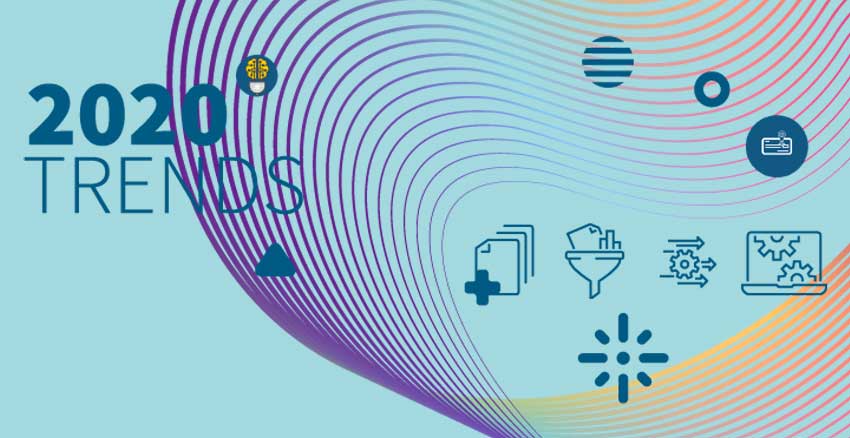As we round the corner to 2020, we face a world where information technology is evolving faster than ever. And companies that don’t keep up will run the risk of being left behind as information agility and business intelligence become hallmarks of digital transformation. What can you do to keep pace in the New Year? Consider these trends and what they might mean to your organization.
Analytics: Addressing the Unstructured Data Dilemma
There is a lot of interest in business intelligence and analytics, but according to research done by AIIM International, many organizations have yet to make the leap; 87% of organizations are still exploring the options or are recent adopters. One reason for this is the difficulty in turning unstructured information — like documents, images, or handwriting — into structured data. This is bound to change in 2020 and beyond as organizations leverage intelligent capture not just for the siloed process of initial transformation for incoming content, but also in broader document automation workflows throughout these organizations. Despite Robotic Process Automation (RPA) and basic capture adoption for highly structured data, few organizations have moved beyond leveraging RPA to automate simple rule-based processes with structured data. However, the need is there; customers are looking to leverage RPA for more complex workflows and unstructured data, which is now possible via intelligent capture.
In 2020, we face a world where technology is evolving faster than ever. What can you do to keep pace in the New Year?
Business intelligence will play an increasingly important role as organizations gain access to all of their information including unstructured data. This will definitely boost organizational performance for next-stage adopters. Organizations with data-enabled analytic strategies will get more value out of the information they have in the enterprise. Not only can analytics tell you if you are successful in your market, but they can help you predict where the markets will move next.
In 2020, it won’t be just about collecting more and more data, it will be about using that data in more impactful ways. One example is in the health care industry where patient data – including health records and claims data – is being combined with predictive analytics to anticipate and prevent unnecessary hospitalizations. Health care providers are constructing statistical models that examine factors such as demographics, medical visits and treatments, and are developing new care plans and strategies that reach patients before emergencies occur. As a result, the emphasis moves from caring for the individual after they get sick to one that is more predictive and proactive; a good outcome for both the patient and the provider. This is just one of the ways data-enabled analytic strategies will drive impactful transformation.
Hand-in-Hand with Analytics: Artificial Intelligence
Deep Learning applications present one of the most transformative technology evolutions of our times. However, if you are not a died-in-the-wool technologist, it can be difficult to understand the true impact of Artificial Intelligence (AI). Hollywood often portrays AI in a future world with smart robots having super-human characteristics, the truth is far from super-human, but these technologies are already at work fueling important changes in the way business is conducted every day.
Leading companies in all industries will up their investments in AI in 2020 with the aim to give birth to an intelligent enterprise that is more agile and innovative, as well as receptive to process improvements that translate directly to the bottom line. Starting with, for example, using intelligent automation to drive productivity and efficiency across universal back office operations that all organizations must manage like order processing, invoicing and accounts payable. Organizations plan to also apply AI to fuel improvements and automation in core processes like human resources, client on-boarding and case management.
In 2020, leading enterprises will up their investments in AI with the aim to give birth to an intelligent enterprise that is more agile and innovative.
Getting the most out of the effort, however, will require that planning and decision-making regarding AI move beyond the boundaries of IT departments to include business users and stakeholders in key process areas.
Mobile Workforce
We live in an age of mobile computing: most Americans own a mobile phone and of those, over 80% own a smartphone. As a result, a mobile workforce will be an important differentiator for 2020 — an agile and flexible approach to a new breed of workforce that embraces an anytime, anywhere and any-device model of productivity.
In contrast to the desktop Internet of the early 2000s, which was largely stationary, Americans today are mobile and connected. As a result, forward-looking organizations are adopting a mobile workforce. According to a study performed by Forbes, 81% of CEOs see a mobile workforce as being strategically important. Most CEOs say having a clear vision of how to leverage mobile technologies can create competitive advantage.
The mobile workforce will have an increasingly disruptive influence next year. The disruption will be felt in every industry. Companies that do not address the advantages of a mobile workforce and remain tied to tradition will be at risk of getting left behind as agility, flexibility and connectivity become bellwether requirements of digital transformation.
Mobile Workforce, AI & Analytics: the Triumvirate
The mobile workforce will be working alongside their digital workforce for those repeatable, dull and time-consuming tasks. Artificial intelligence not only allows for faster access to quality data, it also allows machine learning-enabled software to improve on its previous actions and usage patterns allowing it to implement necessary actions without being manually instructed to do so. With more time and more comprehensive data through intelligent capture, analytics—both on current state and predictive—become possible.
###
Kevin Craine is the author of the book Designing a Document Strategy and host of the Document Strategy Podcast. He is the managing director of Craine Communications Group. For more information visit CraineGroup.com. Author’s note: All thoughts and opinions expressed here are my own and not influenced by the developing company or its affiliates.
If you found this article interesting or would like to find out more about becoming a partner.
Find Out about Becoming a Partner, Discover New Capture Capabilities, Watch the Demo and Get Your Questions Answered
Join us to see a LIVE DEMO of the latest FormXtra.AI capabilities, discover the key factors behind our growth—FormXtra.AI and Smart Learning—and how these can benefit you. And then, get ALL of your questions answered. Hear about our Partner-First Program that focuses on collaboration and technology enablement. Our Smart Learning technology is garnering a lot of attention and leading to a number of highly-competitive wins. Simply put, no one can deliver what we can—including highly accurate handwriting recognition. These wins have resulted in a 7-figure project backlog that is growing, and the total solution opportunity for each deal is many times that; we’d like to work with a very select group of partners to share in this success.





